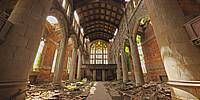
For Want of a Family, the Church was Lost
Gary, Indiana, USA
June 20, 2011, 1:00pm CT
© 2011 Richard C. Drew, All Rights Reserved.
The City Methodist Church is truly a representation of the history, families and life of Gary, Indiana from it's rise through it's decline. When Gary was a thriving, booming town, this Gothic church was constructed so local families had a house of worship to be proud of. Adjusting for inflation, it would cost over $7 million to build today. The town became a city and a thriving metropolis. In the 1960s it was the "go to" place in the Midwest. Then the steel mills closed. Other businesses left. Families moved away. Soon the church was forced to shutter as well, as it's congregation dwindled and could no longer support this magnificent edifice.
The church complex includes a school, meeting rooms, theater, basketball court and more. There are two main buildings in the complex, and because many areas are impassable, it's often difficult to navigate. Some stairs have totally collapsed. Others are fully rubble choked. It often takes a circuitous route to navigate from room to room.
It's a long time since the 1920s, when US Steel fronted the $385,000 to build this church. The building looks like it would be more at home in downtown London, not a couple of miles from Lake Michigan.
The church held it's final service in 1975. All the damage, decay and vandalism has occurred since then. Theft and arson stripped away at the structure. Weather has beaten the church down, each year bringing exponentially more damage — especially during the harsh Indiana Winters. Two years ago the roof was almost intact. One Winter saw some minor damage. The next winter came and went, and 20% of the roof caved in. It's a testament to the quality and dedication of the craftsmen who put their sweat, faith, and hard work into creating this Church. It's survived over 35 years. Fire, flood, snow, wind — you name it. All have ravaged this imposing structure.
The walls in the basement, many of them supporting floors and inner structures, are crumbling. Water infiltration, Winter freeze and thaw, storms. All add to the toll taken on the complex. Some of the interior basement walls are as thin as 1/4" in places, and crumbled to clay dust in others.
The rusting, partially submerged equipment room, holding oil tanks and machinery, is the lowest level of the building, and remains constantly flooded. It may as well be a swimming pool, averaging 2–4 feet deep. The fortress-like bunker-grade construction traps and holds the water. It is crystal clear and still as glass. I only realized it was flooded when my light reflected onto the walls. A rusting ladder leads down. Maybe if I had a boat or Scuba gear I'd explore this small room, but not today!
If the building is beautifully eerie, the basement is just plain spooky. The day I took the photos, it was over 90 degrees outside. In part of the basement it was so cold I could see my breath. Water was constantly dripping and running down the walls. Every surface was damp, cold, clammy and rotting. Humidity was 90% or better. Some rooms were fog-filled, with weak light streaming in through holes in the ceiling. Others were black as a coal mine. Walking was a challenge — much of the floor was spongy, rotting wood, covered in decaying, fallen bits and pieces of ceiling and wall. The wood portions are ankle breaking traps. Everything smelled like rotting wood and rust.
The massive support columns in the Sanctuary are intact, and run from the roof down to the basement and on to hidden colossal footings. Massive steel beams can be seen in other parts of the building. The weakening bones remain intact, but the muscle and skin are slowly disappearing. The church was never called a Cathedral, but it was one, in all but name. The window tracery remains, much of the stained glass long gone, mostly falling victim to rocks and bottles.
Pigeons call the deeper tracery home (yeah, I had to look it up — the tracery is the limestone framing and detail the glass is set in.) Much of it is several inches deep — a perfect nesting place. Literally Pigeon-holed. You'll hear constant cooing and flapping in the Sanctuary, or what many people would simply (and incorrectly) call the Church). That's where this pano was shot.
There have been goth weddings held here in the past few years, and it's a mecca for photographers and urban explorers. This day there were over 30 people there shooting photos, plus a photog shooting a nude model, another photog shooting a fashion layout, and a scout for a wedding planner. "Transformers 3" recently shot here. Several movies have used this as a location. What I did not see — bums, squatters, animals or rodents.
Shelly's "Ozymandias" has a line that could describe this house of worship "...the decay of this colossal wreck..." On any given day, you will meet several fellow Travelers.
This building is rapidly disintegrating. Stairs are often rubble-choked, others putty-like — some are are so weather worn they are closer to slippery ramps. Trees are growing on the various roof levels. Ever see the Anime "Laputa"? Wandering this complex is reminiscent of the Castle in the Sky.
If you are an urban explorer or just interested in these types of vanishing buildings, take the time to visit, if you can. You can experience first-hand what happens when a church loses its family.
Lightroom 3 - PhotoShop CS5 - PTGui - Pano2VR 3


 Tap or click the zoom icon in the bottom right corner of the picture to switch between in-page and fullscreen view
Tap or click the zoom icon in the bottom right corner of the picture to switch between in-page and fullscreen view